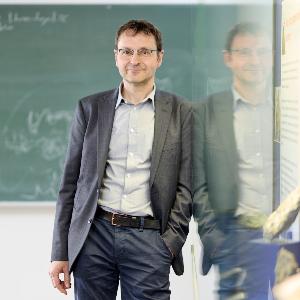Geosciences: Journey to the Earth’s interior
31 Mar 2025
On the computer and in the laboratory, physicist and geoscientist Sandro Jahn simulates geomaterials to understand their properties.
31 Mar 2025
On the computer and in the laboratory, physicist and geoscientist Sandro Jahn simulates geomaterials to understand their properties.

Using his research to look inside the earth: Prof. Sandro Jahn | © LMU/Stephan Höck
It is a long way to the Earth’s interior. More than 6,000 kilometers separate the planet’s surface from its core, where temperatures reach several thousand degrees. Sandro Jahn conducts research into what happens on this journey. To do so, he uses the computer coupled with experiments to simulate what goes on inside our orb.
In September 2024, Jahn took over as Chair of the Interaction of Geomaterials and Living Organisms at LMU, and also as head of the Bavarian State Mineralogical Collection in Munich. Contrast and contradiction are the lifeblood of his research: The geoscientist uses computer simulations and experiments to study minute structures and processes over ultrashort periods of time – the building blocks of the Earth, if you like – to gather information about the Earth as a whole.
“We simulate materials on a nanometer scale in order to make predictions about their properties and understand the processes that take place in the Earth’s interior,” Jahn explains. The scientist is especially interested in how the atomic structure determines the properties of a material. “Atoms move within super-small timescales – in femtoseconds. In contrast, the Earth evolved over several billion years. So, we start to understand properties at the atomic scale and then extrapolate these findings to planetary orders of magnitude.”
Alongside computer simulations, the professor also works in the laboratory with diamond anvil cells to conduct high-pressure experiments in his investigation of material properties.
Sandro Jahn graduated and earned a doctorate in physics at the Chemnitz University of Technology, although he completed his experimental dissertation project at the Institut Laue-Langevin, an international research center in Grenoble. “I’ve always been interested in what the atomic structures of materials look like. As a postdoctoral researcher, that took me to Oxford and to computational chemistry. It was here that I learned to simulate materials at the atomic scale.”
Jahn first started to apply computer simulation to geoscientific issues at the GFZ Helmholtz Center for Geosciences in Potsdam. As head of the Emmy Noether junior research group “Melts and fluids in geomaterials: From first principles to geological processes”, his work complemented the experimental investigations of his colleagues. “If you want to simulate what goes on in the Earth’s interior, you have to combine different methods,” he explains.
Jahn had served as Professor of Mineralogy and Crystallography at the University of Cologne since 2015. Then, in September 2024, he took up his present post at LMU – “which is fantastic”. Why such excitement? In part, the geoscientist says, because of the many opportunities to collaborate with researchers attached to other chairs: “There are lots of overlaps, so we can work well together.”
For example, Jahn is involved in DeepDyn a German Research Foundation (DFG) priority program in which interdisciplinary studies of the dynamics of Earth’s interior seek to gain a better understanding of the planet’s magnetic field.
One focus of Jahn’s work on this project is how crystalline materials conduct heat and how pressure and temperature change their properties. In the depths of the Earth, the pressure is so high that certain crystalline structures are no longer stable and therefore transform into other structures. “We can reproduce that with our computer and laboratory simulations, which in turn helps geophysicists to understand their observations,” Jahn says. “They might be able to measure sound velocity and density, but they can’t see what materials are involved.”
Simulating the materials takes up a great deal of computing time. It produces so much data that Jahn needs supercomputers to conduct his research. Soon, he will also be making use of the supercomputers at the Leibniz Supercomputing Center (LRZ). Laboratory experiments are conducted both at the professor’s chair and at sources of synchrotron and neutron radiation. While his chair at LMU is still “in its early stages”, the professor is already looking forward to the next step forward: when his research unit moves to the new geocampus in Munich’s Schillerstrasse.